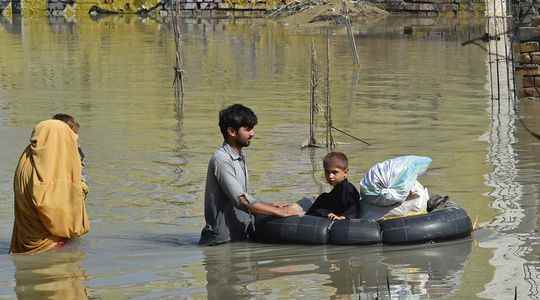The Honeymoon Hotel collapsed like a house of cards. It only took a few seconds for the torrential waters to wash away this well-known tourist establishment, built on the banks of the Swat River, in Kalam, in northeastern Pakistan. More than a third of the country is currently under water, authorities estimate, and,u September 1, half of the 160 districts were affected. These floods are “the worst in the history of Pakistan”, exclaimed the Prime Minister, Shehbaz Sharif.
The toll, still provisional, is cataclysmic: 33 million people affected (i.e. 1 in 7 Pakistanis), more than a million houses damaged, nearly half a million displaced people relocated to temporary shelters and more than 1,200 dead. since June. Thousands of kilometers of roads and 150 bridges were also destroyed, and thousands of hectares of crops devastated.
“The monsoon has gone crazy,” said Faisal Amin Khan, a government official from Khyber Pakhtunkhwa province in northwestern Pakistan. “In my district, 70% of the territory is flooded. The villages have turned into islets, the cars have been swept away, and we are still looking for the dead”, says this local elected official. In some areas of the country, completely submerged, rescue helicopters can no longer even identify dry land in order to drop rations.
“Long periods of drought and short periods of heavy rain”
Pakistan is already one of the main victims of climate change. From March, the country suffered extreme temperatures, reaching up to 50 degrees in places. This early heat wave helped warm the Bay of Bengal and the Arabian Sea. “This year, the waters have therefore evaporated more quickly, leading to more rainfall,” observes Furrukh Bashir of Pakistan’s meteorological department. From June to August, Pakistan received twice as much rain as usual. In the South, in Balochistan and in Sind, they were even more than four times higher than the average of the last thirty years. These heat waves also accelerate the melting of the Himalayan glaciers, more than 7,000 of which are in Pakistani territory.
In South Asia (India, Pakistan and Bangladesh), the disruption of the weather results in erratic monsoons (in addition to cyclones). “Instead of having moderate rainfall spread throughout the monsoon period, we see long dry spells and short heavy rain spells,” said Roxy Mathew Koll, a climatologist at the Indian Institute of Tropical Meteorology.
But rising temperatures are not the only problem. The Pakistani authorities are accused of not having sufficiently learned the lessons of the past. In 2010, the country had already experienced terrible floods which claimed approximately 2,000 lives. The National Disaster Management Authority had then drawn up a risk reduction plan, but most of the recommendations have not been implemented, as this authority has no real power. In this politically unstable and notoriously corrupt country, construction in flood-prone areas and on riverbeds has therefore continued.
The cost of the damage estimated at 10 billion dollars
Today, Islamabad estimates the cost of flood damage at more than $10 billion. Faced with the emergency, the United Nations launched a 160 million dollar plan to help 5 million of the most vulnerable people. The United States, Turkey, China, the United Arab Emirates, Qatar and France have already offered humanitarian aid.
Recalling that it is historically responsible for less than 1% of greenhouse gas emissions, Pakistan is trying to hold the most industrialized states to their responsibilities. Developing countries, which bear the brunt of the negative effects of global warming, have been calling for a financial compensation mechanism for years. A file that they will not fail to put back on the table at COP27, in early November in Egypt.
